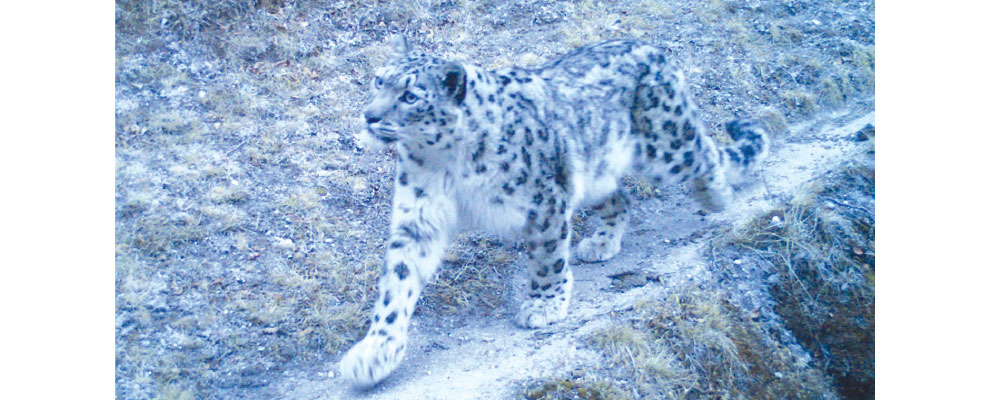
Kathmandu, Oct. 19:The presence of both snow and common leopards in the same mountainous region has prompted conservationists to presume the consequences of climate change at higher elevations.
A recent study conducted in the Gaurishankar Conservation Area (GCA) has revealed that both big cat species were observed in the same mountainous region.
Covering the period from November 2022 to May 2023, the research employed camera traps, resulting in about 55,219 captured images. These images have provided unique insights into the behaviours of these large cats.
Madhu Chhetri, lead researcher, said that this was the first instance of capturing both a snow leopard and a common leopard in the same area in the Gaurishankar region.
Chhetri revealed the results, stating, “Of the 1,816 photographs of various species examined, 29 images revealed the presence of snow leopards across six camera locations. Altogether, 38 images depicted common leopards in eight separate camera locations.”
Researchers set traps for 2,304 nights to spot leopards. They found that for every 100 days and nights of trapping, they saw about 7.51 snow leopards and 9.84 common leopards. Also, the chance of spotting these leopards separately was 0.41 for snow leopards and 0.52 for common leopards.
According to him, “Two camera stations, one at an altitude of 4,260 metres in Lyamadinka Kharka and another at 4,000 metres in Lapchi Deurali, captured images of both snow leopards and common leopards. This observation raised questions about how these two species share and occupy the same habitat in the GCA region.”
Naresh Subedi, Conservation Programme Director at the National Trust for Nature Conservation (NTNC), pointed out that predators tend to follow the movement of their prey. In the GCA, the common leopard shifted to higher elevations in search of food, while the snow leopard descended for the same reason, resulting in their convergence at the same point.
“This recent discovery marks the first occurrence in Nepal. It is possible that they are indeed interacting, but this finding alone does not provide sufficient insights into the nature of their interactions and how they compete for food,” Subedi explained.
According to Subedi, both predators have different characteristics as the snow leopard inhabits the high mountain ranges and the common leopard has a broader range and can be found in various habitats, including forests, and grasslands but their existence at the same habitat can be blamed for the impact of climate change.
But there should be at least five to seven years of study to find out how they interact, what they are doing and how they do competition in the same habitat, he added.
Chhetri explained that in the GCA, like other regions with snow leopards, common leopards and snow leopards might share the same territory. This is because the climate is changing, pushing the tree line higher. As a result, it is becoming more suitable for common leopards, while it could reduce the territory available to snow leopards.
Chhetri explained that due to climate change, leopards are moving north into snow leopard territory. Common leopards are also moving to higher altitudes, which means they are more likely to encounter snow leopards.
The team also made a detailed list of 19 different mammal species found in the Lapchi Valley. Among them, the Himalayan musk deer was the most common, followed by the mainland serow, leopard cat, common leopard, and finally, the snow leopard, Chhetri said.
“The camera traps caught pictures of snow leopards in forests at an altitude of 3,990 metres. This is because there are not enough prey species for them in the higher mountain areas. So, snow leopards come down to the lower parts of the forest to hunt animals like Himalayan ghoral, Himalayan musk deer, and Himalayan tahr, which live in the forest,” he added.
The findings of the research suggest that there is considerable overlap in the habitats of both snow leopards and common leopards in the GCA. “This has raised important questions about competition for food. Snow leopards usually like higher areas, while common leopards prefer forests. But this might be the possible impact of climate change,” he informed.
According to Chhetri, the fact that snow leopards and common leopards are living in the same area in the GCA is very interesting. It helps us understand how different animals interact with each other and how their homes are changing because of the environment.




